
IPCC report: why the detail matters to energy investors
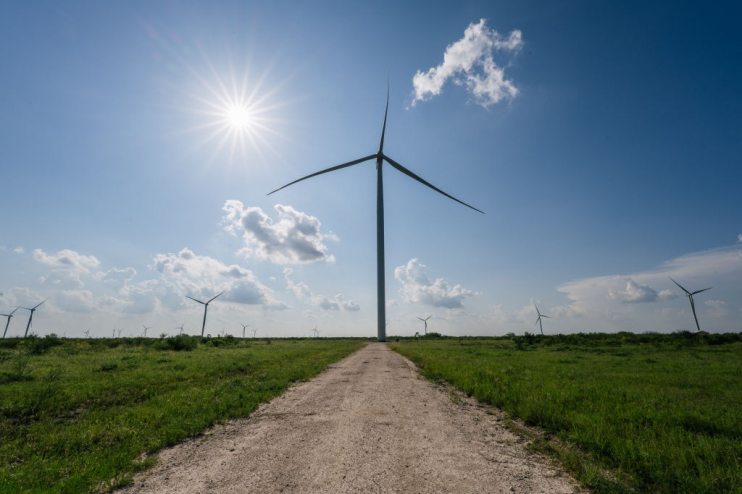
The United Nation’s Intergovernmental Panel on Climate Change (IPCC) report will shock many people.
The data speaks for itself and illustrates the most important challenge facing humanity over the next 100 years. We expect the IPCC report to shock government leaders and lead to actionable policies being implemented at the COP26 climate summit in November.
These policies will provide a more transparent framework for industry participants to accelerate investment and accelerate the energy transition. By investing in industry-leading sustainable companies in areas such as batteries, electric vehicles and wind power, investors are helping to enable the transition while at the same time capturing the benefits of sustainable profitable growth.
The energy transition is a massive challenge, but should also be seen as an incredible opportunity.
The IPCC report – educational and credible
Headlines this week have been dominated by the report from the IPCC. It is a 42 page summary of their findings on the current state of the world’s climate for world leaders.
This is a VERY important report and we have no doubt that it will have a significant influence on all government leaders’ thoughts, actions and future policies when they get together for the COP26 climate summit in Glasgow in a few months’ time. We would encourage anyone to read the report, as it is extremely credible.
Essentially, it’s a summary of the work produced over years of combined effort between the world’s top environmental scientists. Importantly, to avoid doubt and remove controversy, the findings are endorsed by the world’s governments, before the report is released.
The key findings
Just before the report was released, we had some timely reminders of the extreme and unforecastable weather patterns that are becoming more and more frequent. First, with the catastrophic flash floods in Germany, which killed more than 100 people and inflicted significant infrastructure damage. This was followed just three weeks later by mass wildfires in both Turkey and Greece, destroying thousands of acres and resulting in further fatalities.
This is noted very strongly in the data and is explicitly highlighted in the report;
“Human-induced climate change is already affecting many weather and climate extremes in every region across the globe. Evidence of observed changes in extremes such as heatwaves, heavy precipitation, droughts, and tropical cyclones, and, in particular, their attribution to human influence, has strengthened since AR5 (2013)”
The past five years have been the hottest on record since 1850. Meanwhile, global surface temperatures have now averaged 1.1 degree Celsius higher in the last decade versus the period between 1850-1900. Despite these facts, some people still question whether this is down to human influence, but the data is clear and the evidence is unequivocal.
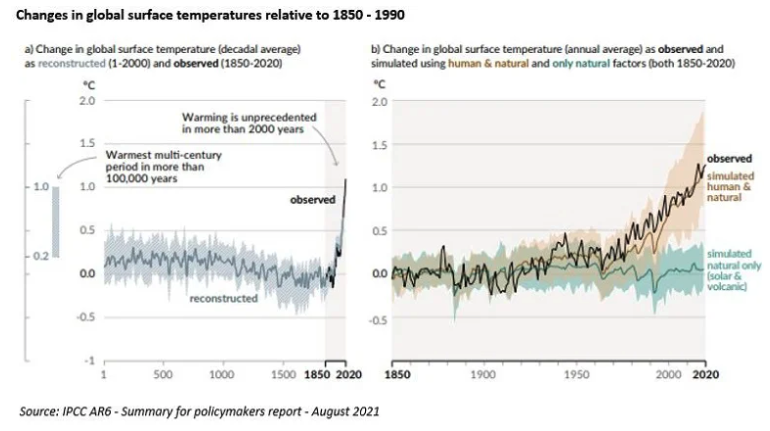
For forward-looking estimates of global temperature increases (and the resulting impact on the atmosphere, cryosphere, oceans and biosphere), the group of scientists put forward five climate/temperature scenarios. These are influenced by the extent to which GHG emissions (CO2 and non-CO2) increase or decrease from here (using 2015 as a base year).
The conclusions of the analysis are disturbing, but at the same time the evidence hammers home the significance and responsibility we all have on reducing emissions for the security of our future generations.
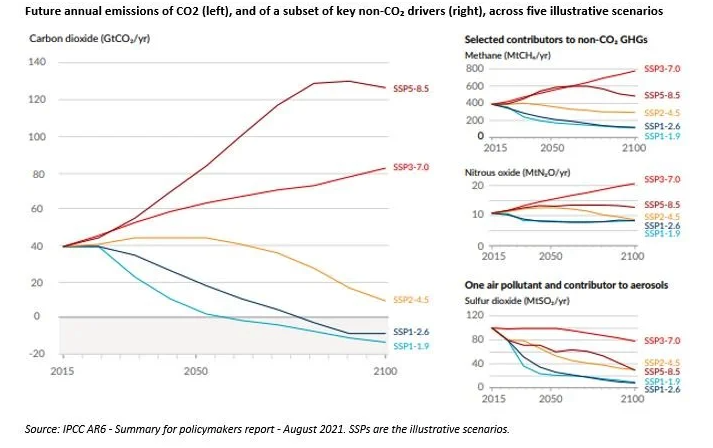
“Global surface temperature will continue to increase until at least the mid-century under all emissions scenarios considered. Global warming of 1.5°C and 2°C will be exceeded during the 21st century unless deep reductions in CO2 and other greenhouse gas emissions occur in the coming decades”.
We have already reached a tipping point. This means that many of the effects of climate change are now unavoidable under all of the scenarios, be that more extreme weather conditions, the Arctic suffering large scale melt, or sea levels increasing.
To put into context what the data is highlighting, not only do we need to get to net zero emissions globally by 2050, but we would also need to proactively remove carbon from the atmosphere from that point onwards in order to limit global temperature increases to between 1 – 1.9 degrees Celsius by 2100.
COP26 – A global policy needs a global carbon price
We think that the COP26 meeting in Glasgow will prove significant as it is the first Conference of Parties to review and strengthen Paris Agreement commitments. The IPCC report however, has highlighted the massive challenge ahead.
In addition, this will be the first formal meeting since the Covid-19 pandemic began, so we can expect to see how nations try to balance their plans for rebuilding economies without causing further harm to the environment. The UK is at the forefront of this, aiming to use the COP26 presidency as an opportunity to call on all countries to set 2030 emissions reductions targets that put us on a path to net-zero by 2050.
It is also the first meeting since the US re-joined the Paris Agreement. We expect the US’s commitments in particular to encourage a global policy that, through investment and a more transparent framework, drives the much-needed change across all industries, in order to deliver the 2050 net zero targets.
In addition, we would also expect to see more nations discuss the goal of adopting formal carbon pricing mechanisms (either taxes or trading schemes) and potentially Carbon Border Adjustment Mechanisms (CBAM) too.
With respect to CBAMs, the EU is phasing this in to provide businesses and other countries with legal certainty and stability. Initially it will apply only to a selected number of goods at high risk of carbon leakage, such as iron and steel, cement, fertiliser, aluminium and electricity generation. Revenues from CBAM will contribute to the EU’s budget, as laid out in the December 2020 Interinstitutional Agreement on budget and own resources.
Using an open market carbon price, the CBAM system works on the basis that EU importers will buy carbon certificates corresponding to the carbon price that would have been paid, had the goods been produced under the EU’s carbon pricing rules.
Conversely, once a non-EU producer can show that it has already paid a price for the carbon used in the production of the imported goods in a third country, the corresponding cost can be fully deducted for the EU importer. Ultimately, the CBAM will help reduce the risk of carbon leakage by encouraging producers in non-EU countries to green their production processes. It also encourages other countries globally to adopt formal carbon mechanisms, something that will again be crucial to achieving our net zero goals.
A CBAM process is already in place in some regions around the world, such as California, where an adjustment is applied to certain imports of electricity. A number of countries such as Canada and Japan are planning similar initiatives, which is a step in the right direction. But in order for it to really adjust capital investment flows away from high emitting technologies and into cleaner technologies, a global mechanism is needed.
Discover more from Schroders by visiting their insights page or clicking the links below:
How are higher commodity prices and shipping disruption affecting the energy transition sector?What investors can learn from Bill Gates’ climate warning
Transparent framework = higher investment and earnings growth
From an environmental perspective the benefits are obvious, but from an investment perspective the transparency and opportunity for long term investors is very powerful. We think that a globally coordinated policy, that provides a stable platform for both public and private investment, will ultimately drive the much needed funding in order to reach the 2050 net zero target.
In the context of the IPCC report’s clear message of the need to change the current upward path of emissions, we really believe that investment levels need to increase substantially from here in order to enable the change.
For example, the chart below highlights the current annual investment rates in the broad subsectors that directly benefit from the ‘energy transition’ infrastructure spend. The current annual investment rates appear large, but it is not enough. It is not enough by a wide margin.
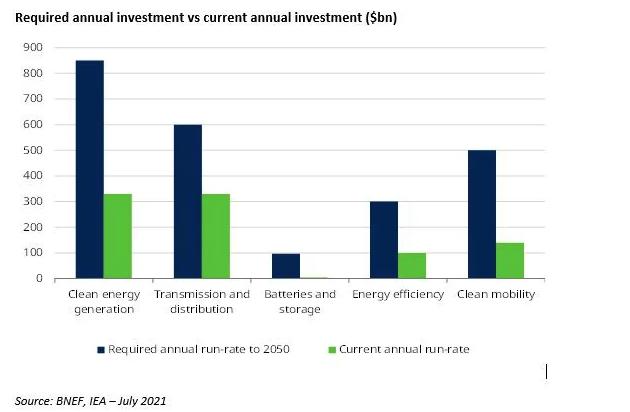
In fact, both the International Energy Agency (IEA) and Bloomberg New Energy Finance (BNEF) estimate, that based on $100 – $120 trillion of the required investment over the next 30 years in order to get to net zero in 2050, the annual run rate of capital expenditure across these five broad sectors needs to DOUBLE from here.
So while some investors may point to the steady and slow investment pace we have seen over the last five years, we would make the point that the ‘real growth’ off a much bigger base is likely to come through over the next few years.
The wind market is a perfect example. Along with other capabilities, the wind generation capacity will need to grow substantially from here in order to fully decommission coal fired power generation by 2050. This is an industry that has been ticking along for the last decade, slowly improving profitability as costs have been driven down to a point that now make the technology cheaper than coal or gas fired generation.
Costs have been driven down through technological advances that have led to bigger, more efficient turbines, and through consolidation, with fewer industry participants having a bigger market share.
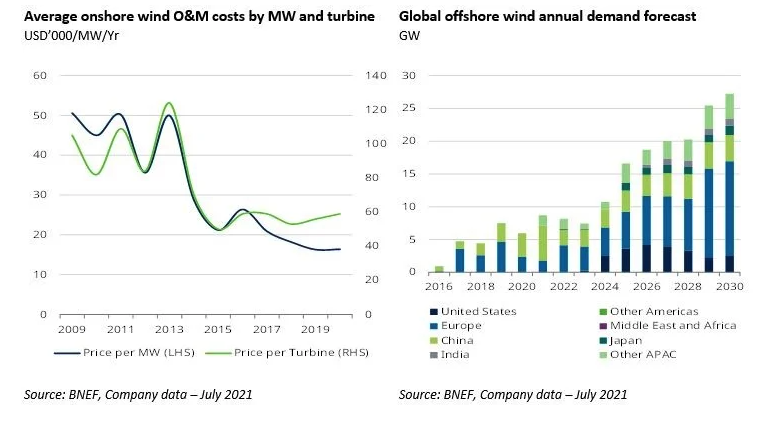
Again, the UK is at the forefront of making offshore wind projects easier to get sanctioned, and encouraging investment in domestic capacity to enable the installation of offshore wind farms. In our opinion, this government support needs to happen globally.
We expect offshore wind installations to accelerate over the next few years, to the extent that we would expect the offshore market to treble in size (in terms of annual awards). Which is extremely positive for turbine manufacturers, array and transmission cable installers, blade manufacturers and wind foundation providers. From an investment perspective the long term growth outlook could not be better.
We expect the global battery market, to be another direct beneficiary of an accelerated and more coordinated government policy. The consumer has a very important role over the next few decades, as we phase out internal combustion engines (ICE) and move towards electric vehicles (EV) in passenger vehicle market.
At this point in time, global policies are inconsistent. Norway has made the bold and proactive decision to phase out ICE vehicles in 2025 and it is already seeing EVs as a percentage of overall sales surpass 50%. But other countries in Europe have varied deadlines, with the UK, Sweden and Ireland phasing out in 2030, while France and Spain opted for 2040. China has committed to 50% of all passenger vehicles being ‘eco friendly’ by 2035, and in the US only really California have committed to a 2035 deadline.
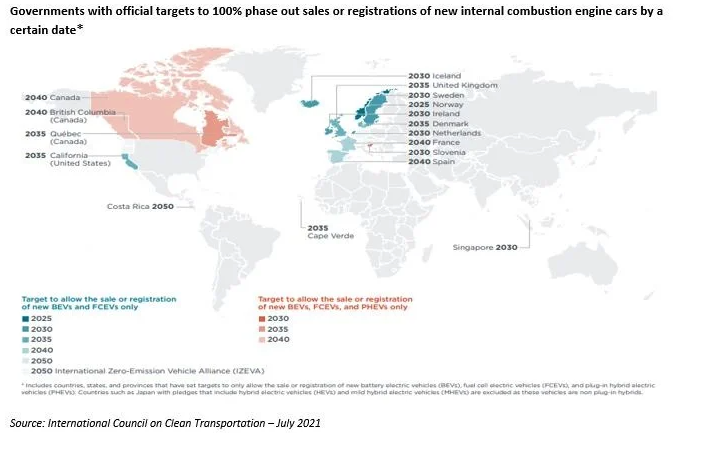
The various deadlines, and more importantly the clear lack of deadlines globally, are not helpful. But again, the IPCC report brings this issue right to the front of governments’ minds as they head towards the COP26 meeting in November. We would expect a significant increase in committed ICE phase out deadlines from governments globally.
The investment requirements for the electrical vehicle market are substantial and if anything we think underestimated. In addition to the OEM manufacturing platforms, there needs to be a significant amount of investment in battery manufacturing capacity and charging infrastructure, in order for this to work and be viable for consumers.
Based on relatively low EV penetration rates in 2030, annual battery demand is expected to grow by ten-fold over the next decade, which we think is likely to prove conservative if more countries commit to a 2030 phase out deadline.
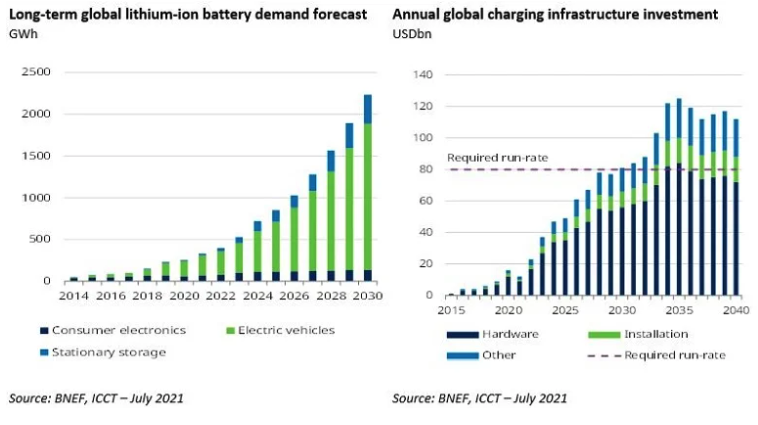
The battery market will still need to grow at very high growth rates beyond 2030, if we are to assume that the 1.4bn passenger vehicle car pool is replaced by the time we get to 2050, which is why the long term investment opportunity cannot be overstated.
Take the US as a good example of how capital investment needs to accelerate. Currently the US has around 20GWh of battery capacity. President Biden will sign an executive order that targets 50% of all cars will be emissions free in 2030. This will require the US to be around 730GWh of production capacity by 2030. Last year US battery capacity grew by just over 5GWh to 20GWh… Investment rates need to pick up!
But this is not the only growth opportunity. Long term, we envisage that the EV will become an important part of grid infrastructure as it will be a device that only draws power from the grid, but one that potentially provides power back into the grid. But the bottleneck before that happens is charging infrastructure. This is another area that needs a significant amount of investment and policy support in order for the infrastructure role out to keep pace with the availability of electric cars to the consumer.
It is estimated that the current capital requirements are only a fraction of what is needed to be spent in order to meet the requirements of a 2030 deadline in key economies. Again, investment rates will have to increase.
In summary, the IPCC’s report has added impetus to what we already knew. Although it paints a gloomy picture, there are grounds for optimism based on the fact that real action will now be taken. The global problem should be seen as a global opportunity.
For more visit Schroders insights and follow Schroders on twitter.
Topics:
Important Information: This communication is marketing material. The views and opinions contained herein are those of the author(s) on this page, and may not necessarily represent views expressed or reflected in other Schroders communications, strategies or funds. This material is intended to be for information purposes only and is not intended as promotional material in any respect. The material is not intended as an offer or solicitation for the purchase or sale of any financial instrument. It is not intended to provide and should not be relied on for accounting, legal or tax advice, or investment recommendations. Reliance should not be placed on the views and information in this document when taking individual investment and/or strategic decisions. Past performance is not a reliable indicator of future results. The value of an investment can go down as well as up and is not guaranteed. All investments involve risks including the risk of possible loss of principal. Information herein is believed to be reliable but Schroders does not warrant its completeness or accuracy. Some information quoted was obtained from external sources we consider to be reliable. No responsibility can be accepted for errors of fact obtained from third parties, and this data may change with market conditions. This does not exclude any duty or liability that Schroders has to its customers under any regulatory system. Regions/ sectors shown for illustrative purposes only and should not be viewed as a recommendation to buy/sell. The opinions in this material include some forecasted views. We believe we are basing our expectations and beliefs on reasonable assumptions within the bounds of what we currently know. However, there is no guarantee than any forecasts or opinions will be realised. These views and opinions may change. To the extent that you are in North America, this content is issued by Schroder Investment Management North America Inc., an indirect wholly owned subsidiary of Schroders plc and SEC registered adviser providing asset management products and services to clients in the US and Canada. For all other users, this content is issued by Schroder Investment Management Limited, 1 London Wall Place, London EC2Y 5AU. Registered No. 1893220 England. Authorised and regulated by the Financial Conduct Authority.
